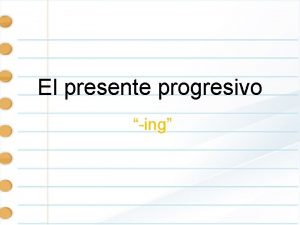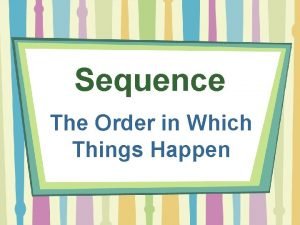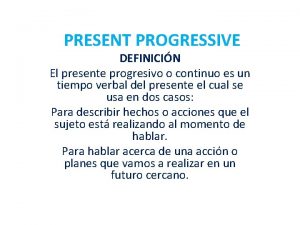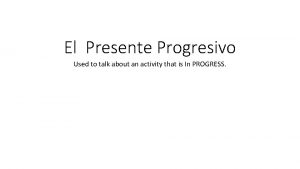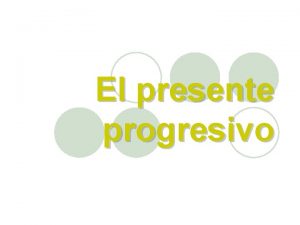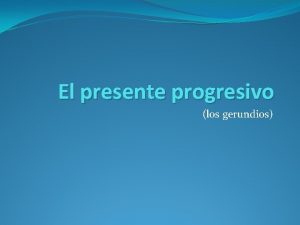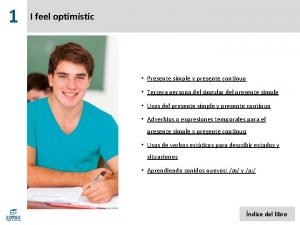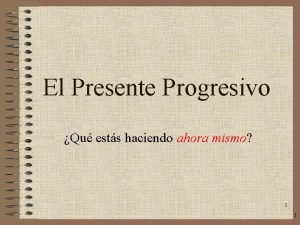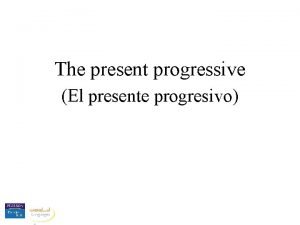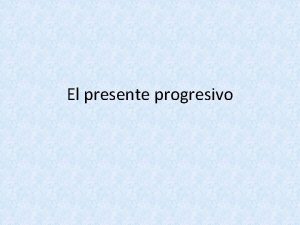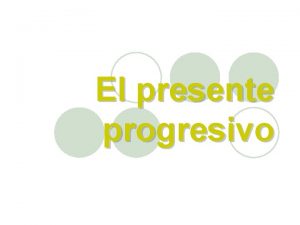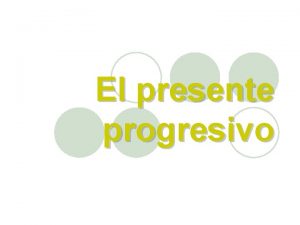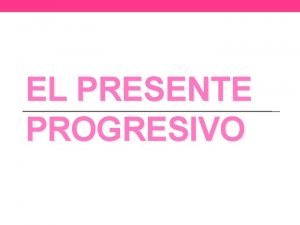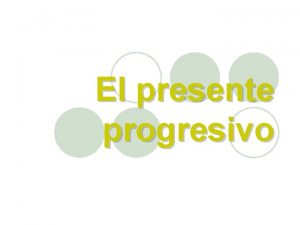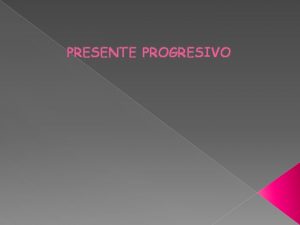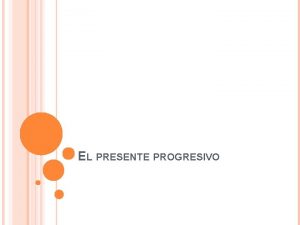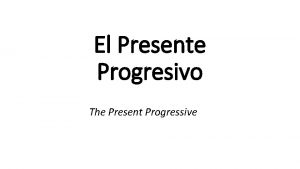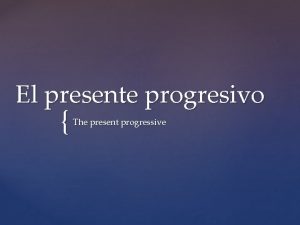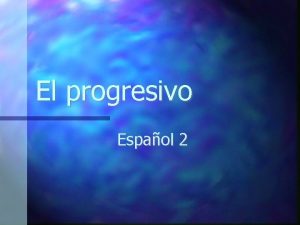Presente Progresivo Whats happen ING Right now PRESENT
















- Slides: 16

Presente Progresivo What’s happen. ING Right now? ? !!

PRESENT PROGRESSIVE In ENGLISH THE PRESENT PROGRESSIVE IS FORMED BY COMBINING THE VERB “TO BE” WITH THE PRESENT PARTICIPLE. (THE PRESENT PARTICIPLE IS MERELY THE “-ING” FORM OF A VERB. ) I AM STUDYING (RIGHT NOW). I AM STUDYING WITH MARÍA (RIGHT NOW).

In English, present progressive can be used to describe what is happening now, or what will happen in the future. I am studying now. I am studying with María tonight. XX IN SPANISH, THE PRESENT PROGRESSIVE IS ONLY USED TO DESCRIBE AN ACTION THAT IS IN THE PROCESS OF TAKING PLACE. IT IS NOT USED FOR FUTURE ACTIONS.

ESTAR + Participle ESTAR (to be) + -ndo (-ing) Forming the Present Participle -AR verbs • Replace –AR with –ANDO – El hombre está jugando al futbol. (JUGAR) • The man is playing soccer. -IR/-ER verbs • Replace –IR/-ER with –IENDO – Lisa está escribiendo una carta. (ESCRIBIR) • Lisa is writing a letter. – La profesora está comiendo una hamburguesa. (COMER) • The professor is eating a hamburger.

• Some –er and -ir verbs will cause 3 vowels to come together in the participle. To avoid this problem, change the “i” of the –iendo to a “y”. • Ejemplos… – Leer leiendo – Construir leyendo construiendo construyendo

The Present Progressive is often used in phone conversations ¡Oye, Pedro! ¿Estás mirando el campeonato de básquetbol? ¡Hola, Simón! No. Yo estoy jugando Call of Duty en línea.

It is commonly used to explain what is happening in a photo. Holly está regateando con el vendedor por una toalla. Andrew está esperando el autobús.

Ellos están abordando el barco.

Holly y yo estamos montando a caballo. (Yo estoy tomando la foto. )

Nosotros estamos buscando estrellas del mar (star fish).

Estamos iendo a la Isla Seona.

Andy y Andrew ____ cola.

¿Qué está haciendo Holly? Ella está…

¿Qué está haciendo el pavo real (peacock)? Él …

Paso 1: Escribe el gerundio (-ando, -iendo) del verbo indicado. 1. Juan está ____hablando______ (hablar) español. 2. Yo estoy ____escribiendo__ (escribir) una carta. 3. Los niños están __jugando______ (jugar). 4. Juan y yo estamos __leyendo____ (leer) unos poemas. 5. Tú estás __estudiando_ (estudiar) el presente progresivo.

• Paso 2: Escribe la forma correcta del presente progresivo. (ESTAR + gerundio) • El padre (escuchar) _está escuchando_ el radio • Los atletas (recibir) __ están recibiendo_ otro trofeo. • Julio y yo (hacer) _estámos haciendo_ un lío aquí. • Los bebés (beber) están bebiendo _ su botellita de leche. • ¡Tú (salir) _ estás saliendo __ temprano! • Yo (llegar) _ estoy llegando__ tarde a mi primera clase.
 En presente progresivo
En presente progresivo Progressive present
Progressive present Right product right place right time right price
Right product right place right time right price Family time
Family time Sequence clue words
Sequence clue words Present progressive
Present progressive Verbo to be
Verbo to be Cut present progressive
Cut present progressive The present progressive is used to talk about
The present progressive is used to talk about El presente progresivo
El presente progresivo Presente progresivo
Presente progresivo Definicion de presente progresivo
Definicion de presente progresivo Presente continuo feel
Presente continuo feel Present continuos forma
Present continuos forma Oraciones con presente progresivo
Oraciones con presente progresivo Presente progresivo
Presente progresivo El presente progresivo
El presente progresivo

